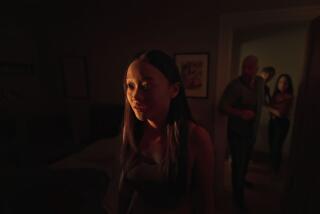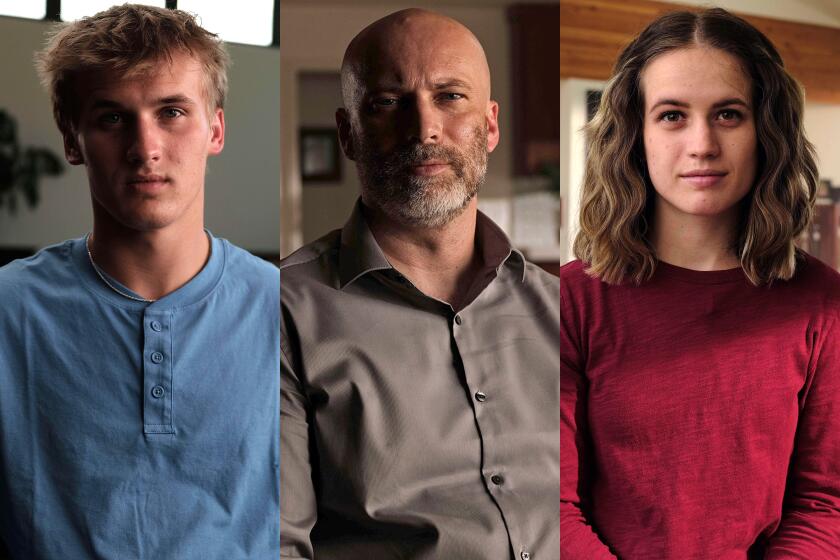With ‘Mosaic,’ Steven Soderbergh allows viewers to choose their own adventure — but please don’t call it that
- Share via
Reporting from New York — The first thing you should know about “Mosaic” is that writer Ed Solomon and director Steven Soderbergh hate when people call it a choose-your-own-adventure series.
Not that they’ve come up with a better term to describe “Mosaic,” which launched as a smartphone app in November and airs as a six-episode limited-series-sorta-thing beginning Monday on HBO.
“It’s just … a thing,” Soderbergh says, shrugging, during a joint interview with Solomon at HBO’s midtown headquarters.
Solomon offers another suggestion: “An ... experience?”
“There’s not even a word for what it is, actually, because it’s not a movie. It’s not a TV show. It’s not a game,” continues Soderbergh, who also dislikes the word “interactive.” “We should be like Prince. It’s just, like, a symbol.”
In lieu of a cryptic glyph, here’s an attempt to explain “Mosaic”: Set in a Utah resort town, it is a mystery focused on the disappearance of Olivia Lake (Sharon Stone), the charismatic author of a wildly successful children’s book. Told from multiple perspectives over a four-year time frame, both the app and the series follow the investigation into her fate, with suspicion focused on the various parasitic characters in her orbit, including con-man fiancé Eric Neill (Frederick Weller) and struggling artist/handyman Joel Hurley (Garrett Hedlund).
In the app version, 15 chapters are laid out in a web-like map. After watching a chapter, usually 15-30 minutes in length, users must select which character to follow next until they’ve reached the end of a thread. Along the way, they can check out so-called “discoveries,” like PDFs of documents relevant to the case, voicemails and additional scenes.
The broadcast version is told in a more traditional, one-hour episodic format, airing on five consecutive nights on HBO (and will be available on HBO Go), but explores the same themes: the malleability of identity, the unearthing of buried secrets and the burden of past success.
While it may not be TV, exactly, “Mosaic” taps into several trends pervading the small screen. Similar to shows such as “Westworld,” “The Affair” and “Mr. Robot,” “Mosaic” is a mystery that plays up the subjectivity of experience, and, like “Twin Peaks: The Return” has prompted conversations about the exact definition of “television.” And by encouraging users to weave their own way through the investigation, the app harnesses the current zeal for true-crime stories (“The Jinx,” “The Keepers,” “Serial”) turning consumers into amateur detectives.
For Soderbergh, the project represents the latest unconventional turn in a career divided among big-budget star vehicles like “Ocean’s Eleven,” experimental features such as “Bubble” and groundbreaking TV projects like “The Knick.” Never a purist — he was an early and enthusiastic adopter of digital filmmaking — Soderbergh is once again pushing the boundaries of format with “Mosaic.”
Soderbergh’s maverick reputation was no doubt a selling point for executive producer Casey Silver, who approached the filmmaker in 2012 about storytelling IP he’d acquired. The pair presented a prototype of the app to HBO, and Chief Executive Richard Plepler pounced, barring the two from leaving the room until they’d agreed to make it with the network.
See the most-read stories in Entertainment this hour »
Partnering with Solomon, whose screenwriting credits include “Men in Black” and “Bill & Ted’s Excellent Adventure,” Soderbergh, a true-crime fan, pondered what sort of story would benefit from the technology. They settled on a mystery built around “a woman who,” as the filmmaker puts it, “walks into the room and the molecules shift.” In other words, a Sharon Stone type.
He recalls pitching the actress before any pages had been written: “I’m like, ‘She attaches herself to people, and then when she’s done with them, she kind of throws them away. Some people hate her and some people love her.’ She just starts laughing. She goes, ‘And I’m supposed to wonder why you thought of me?’”
Together, Soderbergh and Solomon mapped out the beats of the sprawling narrative, using a massive whiteboard covered with dozens of color-coded index cards to ensure that every possible path through “Mosaic” would be comprehensible to users. They also took pains to ensure the story always came first, rather than being reverse-engineered to fit the technology (which was developed by PodOp, Soderbergh and Silver’s company).
“We said, ‘Let’s not ever fall in love with the gimmick of it,’” Solomon recalls.
After plotting a detailed outline with Soderbergh, Solomon wrote the script, which eventually grew to more than 500 pages in length — roughly a hundred pages of which were written during production in Utah as he and Soderbergh figured out the process on the fly. Maintaining continuity was a particular challenge: one of the project’s script supervisors even developed new software to keep track of things.
For both writer and director, who’ve been plying their craft for three decades, it was a uniquely stimulating experience.
“It forces you to think of every character in your story as being worthy of their own movie and why,” observes Solomon.
Stone, who hadn’t done a limited series (or something like it) since “War and Remembrance” in the late ’80s, was lured back into the spotlight to work with the famously fast-moving Soderbergh. Shooting up to 30 pages of script a day was a challenge, but she was game, and responded to the story’s shifting perspectives.
“My process is that I never do two takes the same way anyway,” she says. “I like to put things in my performance for the person who sees the movie the second time.”
For all the emphasis on “Mosaic’s” groundbreaking technology, Stone likens its interactive qualities to the old-fashioned pleasure of going to the cinema. “Steven is so brilliant because he understands that we’ve lost this physiological sense of immersion in the theater,” she says.
As the project was being developed and it became clear he’d need more money to fund the app technology, Soderbergh proposed televising a linear version on HBO.
Not surprisingly, the director, who says he “often rearranges things just for the hell of it,” (see his recuts of “2001: A Space Odyssey” and “Raiders of the Lost Ark”) enjoyed “putting on a different set of goggles” and editing another six-hour version of “Mosaic.”
There are both qualitative and quantitative differences between the two “Mosaics.” The app includes about 7.5 hours of footage, while the linear version runs about 6 hours and is “a more emotional experience for a viewer” with “a specific kind of build,” Soderbergh suggests. Meanwhile, the app offers a meta layer “about your relationship to stories in general,” he says. “It’s like, how do I like stories to be told to me?”
Soderbergh and Solomon are already working on two new ideas that could be using the “Mosaic” technology, maybe even a comedy. And they believe it’s a viable format that could be adopted by other storytellers looking to, say, adapt a tricky novel. They also have access to analytics that will give them insight into how viewers consume “Mosaic.”
“It’s not a novelty,” Soderbergh says.
While the HBO broadcast of “Mosaic” functions as a quasi-official “director’s cut,” Soderbergh is also perfectly comfortable ceding (some of) his authority to viewers through the app.
“We get to decide the size of the playpen, you know what I mean? I still feel like I have all the controls that I want to have as a filmmaker. You could argue, ‘Well, yeah, the viewer kind of gets to do their own edit,’” he says, “and I’m fine with that.”
‘Mosaic’
Where: HBO
When: 8 p.m. Monday - Friday; (concludes Friday at 8:50 p.m.)
Rating: TV-MA (may be unsuitable for children under the age of 17)
Follow me @MeredithBlake
More to Read
The complete guide to home viewing
Get Screen Gab for everything about the TV shows and streaming movies everyone’s talking about.
You may occasionally receive promotional content from the Los Angeles Times.






